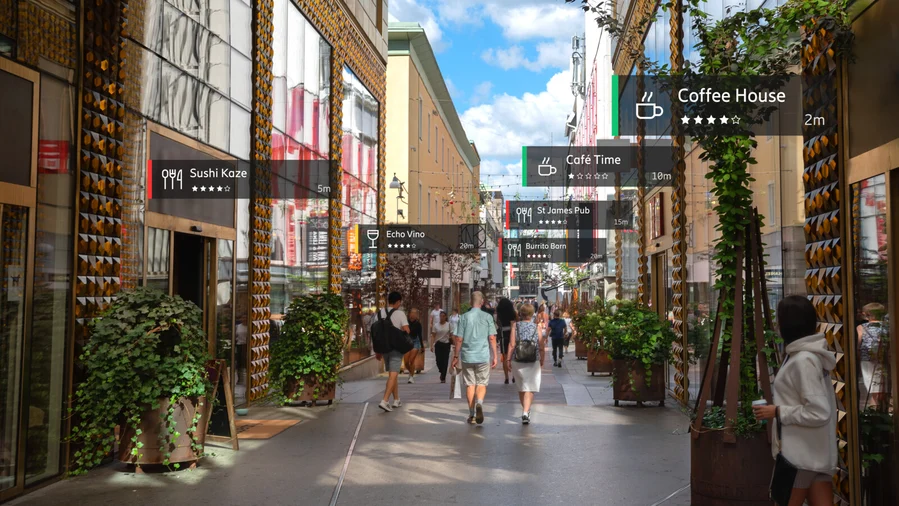
Twice as many consumers combining smartphones and AR devices within 5 years, Ericsson reports
This enables new and exciting ways to engage with the world around us, whether it be through shopping, socializing, or artistic expression. Augmented reality (AR) plays a significant role in various industries and has become more accessible to the average
consumers in recent years through smartphone AR apps.
Today, many young consumers are obsessed with AR filters and lenses on social apps. Other age groups find AR apps to be convenient and efficient in wayfinding, translation, and product try-on or fitting during the shopping journey.
However, consumers face many challenges with today’s smartphone AR experiences, including limited content, low quality of experience, physical strain, and social acceptance.

Similarly, the availability of consumer-friendly XR headsets is still limited, with virtual reality (VR) headsets being the most widespread option. Consumer-friendly AR headsets and glasses are still emerging. However, industry experts believe XR technology, especially AR, will significantly impact consumers and society, with the potential to replace smartphones in the future and become the next paradigm shift. According to the International Data Corporation (IDC), AR headsets are expected to grow in 2024, even though at a slower pace compared to VR headsets, but diversification among the different products will increasingly address more needs. (idc.com report 2023).
Since 2017, ConsumerLab has explored the growing consumer expectations in XR in several reports. In the report titled ‘Merged reality’, we explored how both AR and VR could potentially transform consumers’ daily life. This report uncovers current consumer XR adoption and future expectations for augmented reality experiences and devices in the next five years.
While AR apps on smartphones have offered a taste of this technology, a new era is dawning. Consumers are yearning for lightweight, portable AR devices that go beyond smartphone screens, and the industry is listening.
This article explores insights from a comprehensive Ericsson ConsumerLab study, surveying over 10,000 early AR adopters globally. We’ll delve into four key takeaways that illuminate consumer expectations and industry trends shaping AR experiences over the next five years.
1. A Double Act: Smartphones and AR Devices
Smartphones have become an extension of ourselves, and while they’re the current gateway to AR experiences, user satisfaction remains low. However, the study revealed a fascinating trend: consumers who use both smartphone AR apps and VR/AR/MR headsets/glasses report higher satisfaction. This highlights the complementary nature of these devices. In the next five years, the number of users combining smartphones and AR devices is expected to double, suggesting a future where these technologies work in tandem.
2. On-the-Go AR: A Burning Desire for Portable Devices
Currently, VR/AR/MR headsets/glasses are primarily used within homes. However, the future of AR is mobile! Three-quarters of consumers expressed a desire to use AR devices beyond their homes, mirroring the evolution of the phone from a stationary device to a ubiquitous personal essential. Consumers are even willing to pay a premium for portable AR glasses, envisioning them as companions in various settings like arenas, shopping centers, and cafes.
3. A World Reimagined: Location-Based AR Experiences
As AR technology advances, so too will the range of experiences it offers. The study predicts a three-stage transition:
- Stage 1: The Basics Take Root: Basic social and informational AR applications will become widely available.
- **Stage 2: Stepping into the World: **Location-based and geospatially aware experiences will emerge, transforming how we interact with physical spaces.
- Stage 3: A Native Reality: Advanced, seamless AR experiences will become commonplace, blurring the lines between the physical and digital worlds.
4. Bystander Privacy: A Hurdle to Overcome AR experiences
While early adopters are enthusiastic, widespread AR adoption faces challenges. One significant concern is bystander privacy. Many users hesitate to wear AR devices publicly due to worries about being captured on video or having their surroundings recorded. Addressing these concerns through technological advancements and social acceptance campaigns will be crucial for widespread adoption.
The evolution of AR hinges on collaboration across the entire ecosystem. From improving network connectivity to addressing privacy issues, concerted efforts are needed to unlock AR’s full potential. As portable AR devices gain traction, our relationship with technology is set to transform, seamlessly integrating the digital into the fabric of our daily lives. AR experiences











